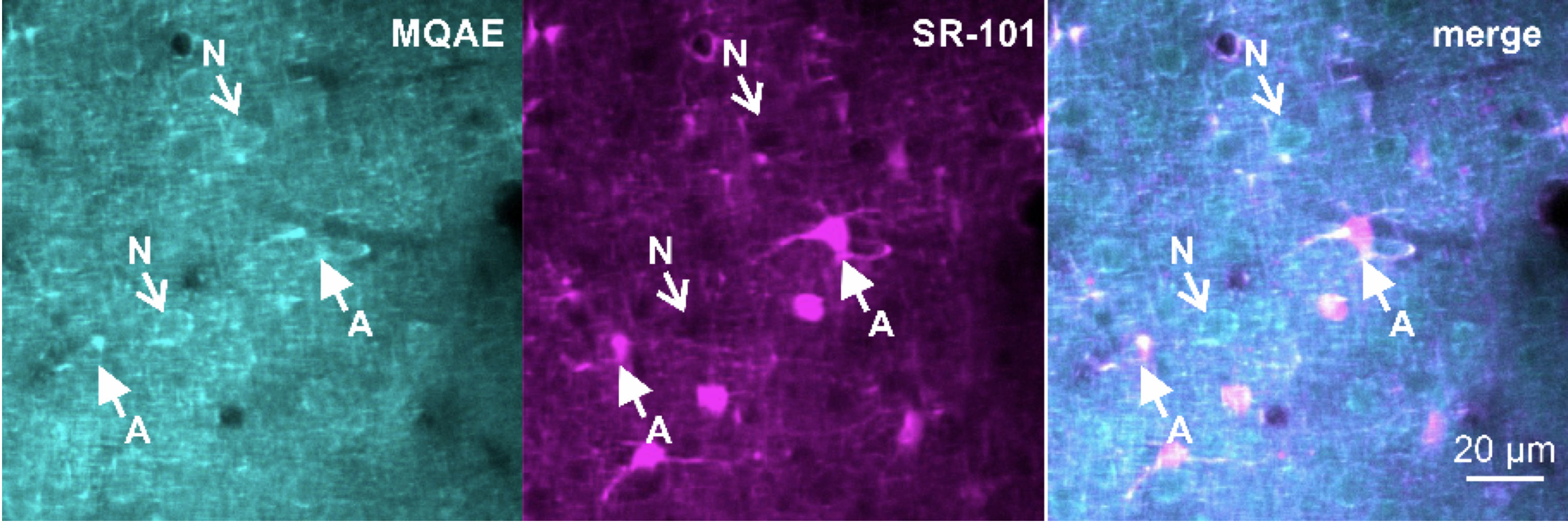Master project - The role of astroglial chloride homeostasis in brain function
Last updated: 22 november 2023.
Chloride (Cl-) is the major anion in the central nervous system, and it plays a crucial role in inhibition. Inhibitory neurons are expressing ligand gated Cl--channel (GABAA receptors) which bind inhibitory neurotransmitter (GABA) and mediate Cl- currents. Since the intracellular Cl- concentration ([Cl-]i) in neurons is low, the Cl- gradient across the membrane facilitates Cl- influx, hyperpolarization and triggers IPSPs (inhibitory postsynaptic potentials). The synaptic cleft is very narrow, and changes in extracellular Cl- will affect the efficacy of neuronal inhibition. Astrocytes which also express GABAA receptors are surrounding synapses and are supposed to have high [Cl-]i. Opening of Cl- channels will lead to Cl- efflux into the synaptic cleft and thus fuel neuronal inhibition. In that sense, astroglial [Cl-]i plays a crucial role in maintaining neuronal inhibition, and it becomes crucial for normal brain function. However, the actual [Cl-]i in astrocytes and the transporters and channels which maintain astroglial chloride homeostasis in vivo are still unknown. In order to investigate the role of astrocytes in inhibition, we perform Cl- imaging in the mouse cortex in vivo in awake behaving mice. The Cl- sensitive dye MQAE can be employed using fluorescence intensity imaging as well as using Fluorescence Lifetime Imaging Microscopy (FLIM). FLIM is an advanced fluorescence imaging technique that allows for absolute [Cl-]i measurements in vivo.

Astroglia and Neurons of cortex loaded MQAE (Cl- dye) in vivo. The Astroglial marker SR-101 labels Astroglia.
We are looking for a highly motivated student that is interested in advanced fluorescence imaging, neuroscience and astrocytes in particular. The project includes the methods of in vivo two-photon imaging with the read out of fluorescence intensity as well as fluorescence lifetimes.
The project will be performed in the Nedergaard lab at the University of Copenhagen. The international research group is highly interactive. In weekly meetings with the CTN in Rochester, data, results and ideas are discussed. The lab language is English, and international as well as Danish students are welcome.
The project is under supervision of Dr.rer.nat. Verena Untiet. Verena studied Biology in Munich and Aachen, Germany. She obtained her PhD at the University of Düsseldorf, while working at the research center Jülich (Helmholtz Gesellschaft) where she also did her first postdoc. Since January 2018, Verena is working as a postdoc in Maiken Nedergaard’s lab.
Please send your application including a short CV and a short letter of motivation to Verena Untiet.
Verena Untiet - Center for Translational Neuromedicine - Division of Glial Disease and Therapeutics - University of Copenhagen - vuntiet@sund.ku.dk
